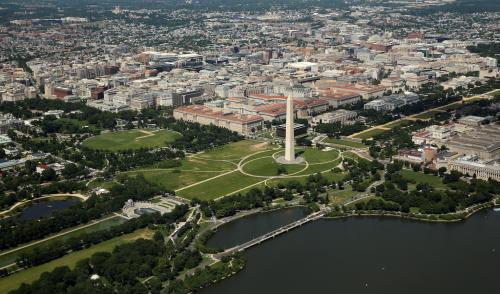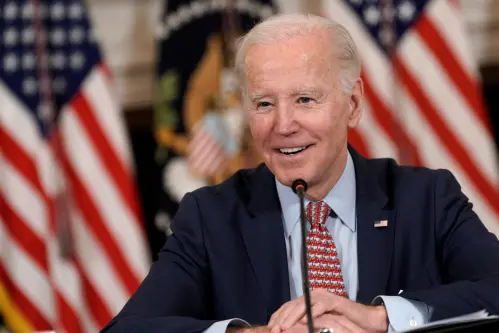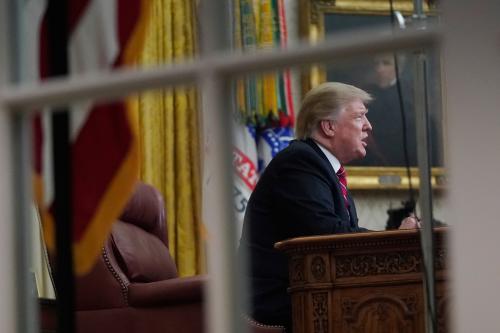A November 2019 survey by SSRS strongly suggests that the 2020 Democratic field is spending too much time promising a bigger federal government that provides more services and not enough time on the need for major reform in how the federal government delivers on the promises it makes. In a new Volcker Alliance report, “The Rebuilder’s Dilemma,” we use this survey to provide fresh data on what Americans want from government.
This analysis provides a clear warning to the 2020 Democratic candidates: Absent a promise to improve federal performance, Democratic voters could face a choice between (1) a Republican president who rarely misses an opportunity to criticize the federal government and promote a smaller government that delivers fewer services, and (2) a Democratic candidate who rarely misses a chance to embrace a bigger government that delivers more services but has little to say about making government work.[1] Unless Democrats offer a credible government reform agenda to match their inventory of new programs, the rebuilders may conclude that Trump is the safer choice. This is the rebuilder’s dilemma in 2020.
This warning emerges from six takeaways presented in this report:
The public demand for very major government reform is near a twenty-year high. As shown in figure 1, the number of Americans who believe the federal government needs very major reform rose from 37 percent in 1997 to 61 percent in November 2019. This increase reflects a mix of public concerns about waste and inefficiency in government, the role of special interests in running government, mediocre ratings of government performance, and reactions to highly visible government breakdowns such as the opioid crisis and mistreatment of children at U.S. border detention centers.
Party identifiers are less likely to favor very major reform when their party is in power. Though this statement holds overall, Figure 2 shows that Republicans expressed a greater demand for reform three years into Trump’s first term than Democrats did at the same point in President Barack Obama’s first term. Trump’s own attacks on government may explain the higher Republican demand for reform.
Americans divide into four groups based on their demand for government reform and support for bigger or smaller government:
- Dismantlers support both a smaller government that provides fewer services and very major reform, and lean Republican.
- Rebuilders support both a bigger government that provides more services and very major reform, and lean Democratic.
- Streamliners support a smaller government, think the federal government is basically sound, and lean Republican.
- Expanders support a bigger government, think the federal government is basically sound, and lean Democratic.
Trump’s reelection depends on Republican dismantlers, while the 2020 Democratic candidate will depend on the Democratic rebuilders. As Figure 3 indicates, dismantlers accounted for 44 percent of the Republicans in November 2019, while streamliners trailed at 30 percent. In turn, expanders represented just a 23 percent share of Democrats and rebuilders, at 47 percent, over double that. Trump’s next campaign is clearly focusing on dismantlers, while the Democratic field started the primary season with a long list of promises designed to activate expanders.
The rebuilders and dismantlers will determine the 2020 election. As Figure 4 shows, Trump won the largest share of his 2016 support from dismantlers. In turn, Hillary Clinton won her largest share of support from expanders.
Asked in August 2016 who they intended to vote for in the general election, 93 percent of Republican dismantlers said Trump, while 100 percent of Democratic expanders and 97 percent of Democratic rebuilders said Clinton.
The greatest threat to Trump’s reelection could come from Republican streamliners who might lean toward a moderate Democrat, while the greatest threat to the eventual Democratic nominee could come from Democratic dismantlers who might lean away from a liberal Democrat. The number of Republican streamliners almost tripled between 2016 and November 2019, from 11 percent to 30 percent; the number of Democratic dismantlers rose from 13 percent in 1997 to 27 percent in April 2019 before dropping back to 20 percent in November. The Republican streamliners are increasingly isolated within their party, partly because of their more moderate positions on government performance. They are less likely than Republican dismantlers to describe themselves as very conservative, express anger and frustration with the federal government, and view the federal government as almost always wasteful and inefficient. As such, they may be more open to a moderate Democrat who promises to repair government.
[1]. Party identifiers include respondents who said they usually think of themselves as a Democrat or Republican or lean more toward the Democratic or Republican Party.







Commentary
Six ways the demand for government reform will shape the 2020 election
February 26, 2020